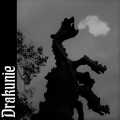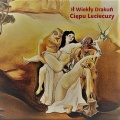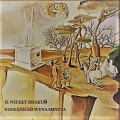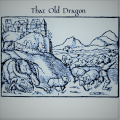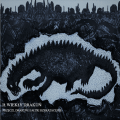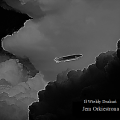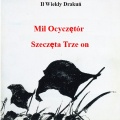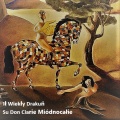Ił Wiekły Drakuń
| This article is a proposal
|
Ił Wiekły Drakuń (translation: That Old Dragon) was a Venedic Zone rock band. They were the first rock band from the Republic of the Two Crowns to have success abroad, entering in the charts of several European countries and played in several tours across Europe and North America, both as openers for already established bands and in their own name.
Personnel
Note, only members who participated in recordings are listed here.
Frączyszek Marcinu: lead vocals, violin, and cello
Floręć Prowany: keyboards (piano, electric piano, spinet, celesta, orchestron, clavioline, trautonium and harmonium), backing vocals
Marzyn Pazany: flute, recorder, and clarinet
Jerzy Pietrzyn: bass and backing vocals
Frączyszek Dziakuń: drums, timpani, and percussion
Frączyszek Dziłmuć: drums and percussion
Piotr Terenik: drums and percussion
Romuald Marzyn Kranc: electric and acoustic guitars and harp. Occasional lead vocals.
History
Formation and early years (1970-1972)
The original core members of the band were all students from the Universtity of Kordyn (*here’s* Krakow): Frączyszek Marcinu (vocals, violin), Floręć Prowany (keyboards) and Marzyn Pazany (flute), all coming from classical music backgound but soon influenced by the small local zonee scene.
Between 1970 and 1972, the band had several line-ups (always keeping the three core members) and several names until they settled themselves as Drakunie (The Dragons), based on a local dragon legend. At that time, they did not play any original songs in public, just versions from foreign bands, although they often rehearsed several original compositions.
Finally, in 1972, Prowany, who had bought the first album of Henderson, Lockwood, Enfield and Pitman (HELP), was amazed by the introduction of electronics into rock music. Being aware of all new possibilities such brought he introduced to the other members of the band his ideas.
Thanks to crowdfunding among their families and their university colleagues, they were able to buy a clavioline and later to rent a local recording studio where they recorded their first single combining rock music and zonee feel to classical music. Erudite rock was born, at least in the RTC, and the band stopped playing covers in their concerts during next months.
National success (1972-1975)
The single Czelebraceń (Celebration) was only available in few local record shops or at the band’s concerts. It became a regional success among the university students and sold out. The band sent a copy of the single to Dzieszekie Wenedkie "Muza" record label (the largest in Veneda) and, surprisingly, Drakunie was invited to make auditions thinking in a future album recording. Self-titled debut album went on sale during 1972 and became the best-selling Wenedyk sung rock album nation-wide.
Drakunie became Ił Wiekły Drakuń (That Old Dragon) during 1974, following the trend among zone rock bands to avoid mascot-like names. Under their new name they released their second album that year after it was delayed for Dziakuń’s first arrest for possession of drugs. Ciępu Leciecuzy (Joyful Time) kept the style of their first album with its more acoustic approach to erudite rock sub-genre, being less electronic driven than HELP’s approach to music and relying strongly in acoustic instruments (violin, flute, and piano). It received particularly good reviews (which were undecided if it was rock music disguised as classical music or vice versa) from the national press and surpassed the sales of the first album, establishing their road to success.
International recognition (1975-1980)
Their third album was released in 1975. Rzekątaceń Wyna Minuta (Story of One Minute) became a massive success in the RTC entering directly to number one in local charts during first week on sale. It was the first time a national rock band made such an achievement. This album was still greatly inspired by classical music, though this time it introduced the Orchestron to the national rock scene; it received incredibly good critical reviews even abroad.
Such success permitted them to go on a four-month sold-out tour around the country. When they returned home, they started to work on their next album which was released next year. Pro Omik (For a Friend) followed the style of previous album: classically inspired with a strong presence of Orchestron. This caused many to compare them to contemporary Tyrean Yesman. Pro Omik was another success, both nationally and internationally. Some foreign critics even considered Ił Wiekły Drakuń as one of the most important zone rock bands of the moment.
The band opened the three concerts that Tyrean Yesman performed in the Republic of the Two Crowns (Warsina, Vilnius and Łódź) during their 1976 world tour. Ił Wiekły Drakuń also went in their first European tour during three months, performing in Bohemia, the Holy Roman Empire, Austria, the Federated Kingdoms, and France, and they were the first foreign zone rock band to perform in a snorist country (Hungary), taking advantage of the liberalization of Hungarian regime by Regent István Oros combined with the fact that the band was less political than many other zone rock bands.
Aiming for the foreign music market, the band re-recorded several of their tracks from Rzekątaceń Wyna Minuta and Pro Omik in English. Lyrics were provided by Tyrean Yesman’s Peter Seinfeld. Released late 1976, That Old Dragon wasn’t so well received by the critics as previous records, considering them rather redundant. Even the band wasn’t satisfied with the result; they didn’t like Marcinu’s accent and were also not entirely pleased with Seinfeld’s English lyrics. They would never repeat a foreign language album again. Although, this gave international audiences an easier name to remember, as since then Ił Wiekły Drakuń was often referred to internationally as That Old Dragon.
During 1977 and 1978, the band looked for a new style to follow. Przęczi, Drakuń i Jałtry Rzekątacenie (The Princes, the Dragon and Other Stories), was the band’s first concept album. Released in 1977 at the start of the heyday of zone rock and its excesses, it took advantage of previous successes despite being considered the weakest Ił Wiekły Drakuń’s album until then and briefly taking the band to the folk-zone realm. It was based in Venedic folklore, notably the local dragon legend in the origin of the band’s name. Meanwhile, drummer Dziakuń was arrested for drugs possession one more time. He would never return to the band, being replaced by Frączyszek Dziłmuć.
The eighth album, titled Jem Orkiestrona (Orchestron Storm) and released in 1978, brought the band to symphonic zone rock as it happened among many zone rock acts worldwide during late 1970's. Instead of using string ensembles, or even an orchestra, their sound was heavily based on the Orchestron, which was rather unusual for the symphonic zone style. At the time, critical reviews considered it a copy of what Tyrean Yesman had done during their 1974-75 period. The album also lacked a proper drummer. Despite being not well received back then (both by the critics so as by the fans), nowadays it is considered terribly underrated by 1970’s critics and is regarded as one of the best local symphonic zone rock albums ever. It also marked the time Ił Wiekły Drakuń lost its position as the leading zone rock band in the RTC to Orkiestra Z.
In early 1980, they released Mil Ocyczętór Szeczęta Trze on (Eighteen Sixty Three), now with a new and better drummer, Piotr Terenik. It was the band’s second and last concept album, released as a double album. It was themed around the 1863 popular uprising in Volhynia, and was, by far, the most political of the band’s records. It also marked the return to the erudite rock sub-genre. Contemporary critics and fans enjoyed the return to the band's original style, although it wasn’t considered as good as pre-Jem Orkiestrona works. It was too long, having space for both good and not-so-good tracks.
On August 1980, Ił Wiekły Drakuń was one of the two Venedic zone rock bands (the other was Orkiestra Z) to perform at Canterbury Rock Festival, the largest zonee event ever. After that, Pazany left the band due to disagreements with some of the other members.
Final years (1980-1986)
The next album, Su Don Ciarie Miódnocałie (I Am the Lord of the Northern Land), was released in 1981. Reviews were mixed, and people often thought the band had lost much of its identity without Pazany’s flutes. With its overblown and complex style, comparisons with late 1970’s Tyrean Yesman’s albums once again arose. Even so, it sold reasonably well and was toured across Europe and North America.
The tenth and final album, Kapiteł 10 (Chapter 10), was released in 1984. Critics were unanimous; they considered it one of the best zone rock albums of the year and the band’s best since Pro Omik. The style was complex, with long tracks where every member had the chance to show what they could do in terms of musicianship. But sales weren’t as good as critical reviews would suggest. The mid-1980’s were harsh years for zone rock, as it was becoming outdated by other rock music tendencies, and record labels were starting to stop supporting creativity without good sales results. After touring, the band decided to end activities in 1986, re-uniting several times since then for sold-out concerts to enthusiastic nostalgic former zonees.
Legacy
Ił Wiekły Drakuń introduced new instruments, notably the trautonium, clavioline and Orchestron, into the RTC popular music, being also among the first worldwide. They were also among the first to combine classical music influences in a zone rock context. By developing these ideas independently from others (notably from the English band Henderson Enfield Lockwood and Pitman), they claimed to be one of the fathers of the erudite rock sub-genre. Such innovations, combined with a string of consecutive well selling and critically acclaimed albums, have earned Ił Wiekły Drakuń a spot among the most important bands in the zone rock scene. They are also considered one of the bands that influenced the birth of Moskal rock, snorist countries zone rock, thanks both to geographic proximity and for their performances in Hungary which inspired lots of local young musicians.
